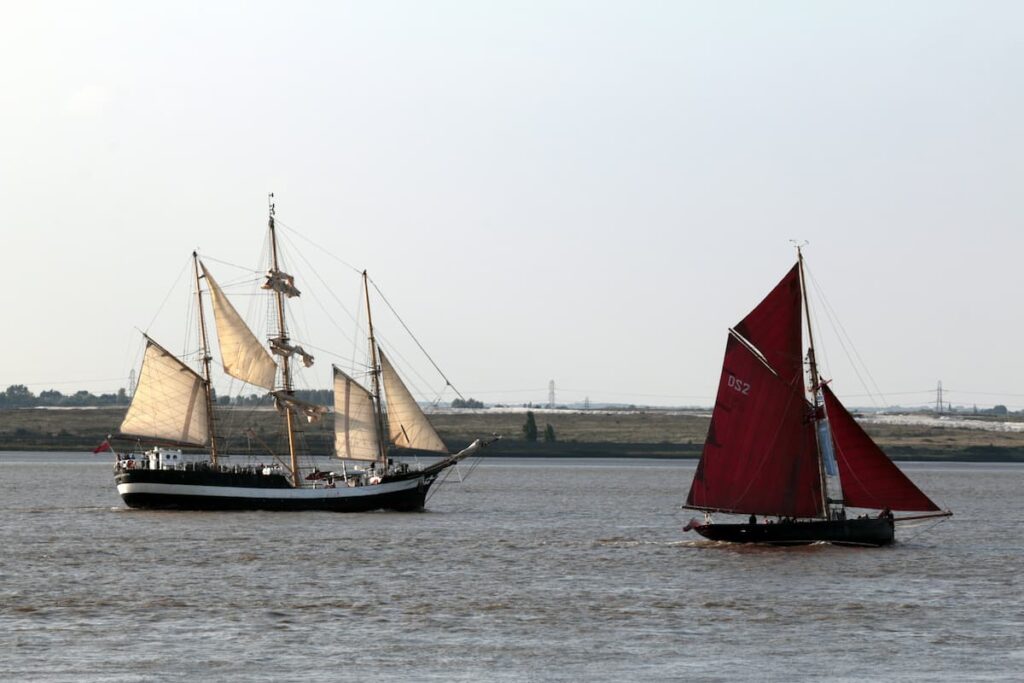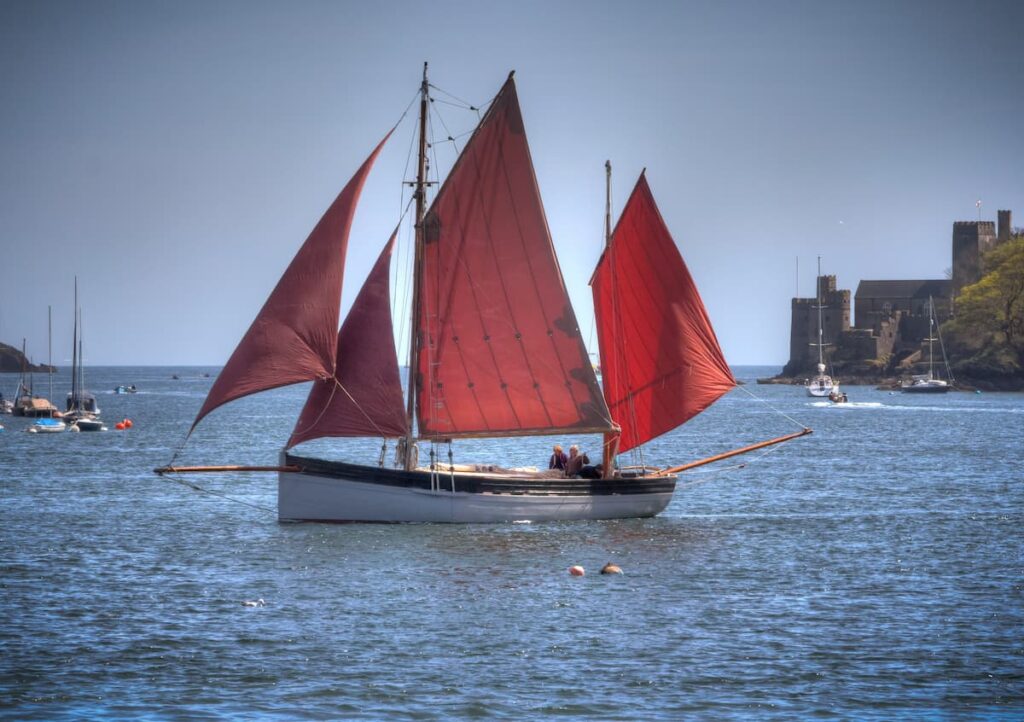As we unfurl the canvas of our conversation today, our compass is set on a fascinating topic: What Are Tanbark Sails?
Anchoring this discussion in the wide sea of sailing knowledge, let’s navigate through the history, advantages, disadvantages, types, making, and maintenance of tanbark sails. Hang on, it’s time to hoist the sails on this intriguing subject.

What Are Tanbark Sails?
Tanbark sails, the distinctive chocolate-brown sails you might spot among a sea of white ones, are more than just a style statement. These sails owe their unique color to a process of tanning that involves soaking sailcloth in a solution made from tree bark, specifically oak bark, rich in tannins.
This tanning process is not merely for aesthetics but also serves practical purposes. Not only do tanbark sails provide a dash of color to your sailboat, but they also boast enhanced durability and resistance to elements. Moreover, they are known for their UV resistance, reducing the damage caused by relentless sun exposure. Tanbark sails are like that seasoned seafarer on your boat – resilient, reliable, and ready to weather the elements.
The bark from which tanbark sails get their name and color is not just any tree bark. It’s predominantly derived from oak trees due to its high tannin content. Tannins, the compound responsible for the tanbark sails’ characteristic color, imparts a natural dye, staining the sails a shade of brown, ranging from warm amber to a deep chocolate hue.
The process of tanning sailcloth isn’t a new-fangled innovation but a time-honored tradition dating back centuries, which leads us to the next stop on our sailing journey – the history of tanbark sails.
History of Tanbark Sails
Tracing the origin of tanbark sails is like embarking on a journey back in time. This tradition of tanning sailcloth has been around since the time when cotton sails were the norm. Our ancestors discovered that tannin-rich oak bark could protect these cotton sails from mildew, mold, dirt, and even the dreaded UV rays. This natural stain was also a brilliant way of using available resources to improve sail performance.
Over time, as sailcloth technology evolved and materials like dacron became more common, tanbark sails began to fade into the horizon. Today, however, these brown sails are making a comeback, primarily as a nod to the nostalgia of sailing’s rich history, coupled with the added benefits they offer.
While we’ve had a glimpse into the past, let’s set our sights forward and understand the pros of using tanbark sails.

Advantages of Tanbark Sails
Tanbark sails have a host of advantages that can make them an appealing choice for any sailor. Here’s a snapshot:
- Durability and Resistance: The tannin present in the tanbark not only colors the sails but also enhances their durability. This natural compound makes the sail resistant to harsh elements, including UV rays, mildew, and mold.
- Visibility: Unlike their white counterparts, tanbark sails stand out on the water. This high visibility can be beneficial in crowded sailing conditions or foggy weather, enhancing safety.
- Aesthetic Appeal: The rich brown color of tanbark sails can add a unique touch of charm and vintage appeal to your boat. It’s a great way to stand out from the crowd and make a style statement on the water.
- Low Maintenance: Tanbark sails, thanks to their color, are less likely to show dirt and stains. This feature makes them relatively low maintenance compared to white sails.
As we weigh anchor and prepare to set sail into further depths of our topic, we will also discuss the disadvantages of tanbark sails, providing a balanced perspective on this subject.
Disadvantages of Tanbark Sails
While tanbark sails carry a fair wind of benefits, it’s important to consider some of the possible drawbacks as well:
- Higher Cost: Owing to the additional process of tanning involved in their manufacturing, tanbark sails often come at a higher price point compared to standard sails. This premium can be a consideration for budget-conscious sailors.
- Availability: As tanbark sails are less common than their white counterparts, finding a sailmaker who offers these sails or sourcing replacement sails quickly might be challenging.
- Heat Absorption: The darker color of tanbark sails means they absorb more heat compared to white sails. This can lead to higher temperatures on your sailboat, which might be uncomfortable, especially in warmer climates.
Understanding both the advantages and the disadvantages can help you make a well-informed decision on whether tanbark sails are a good fit for your sailing needs.
Types of Tanbark Sails
Now, let’s dive deeper into the different types of tanbark sails. The kind of tanbark sail you choose would depend on your sailing needs and personal preference:
- Traditional Cotton Tanbark Sails: These are the original tanbark sails, made from cotton and tanned using oak bark. They carry an old-world charm and are perfect for classic or historical boats. However, they are not as durable or long-lasting as their modern counterparts.
- Dacron Tanbark Sails: These sails are made from modern dacron sailcloth, dyed with tannins to achieve the characteristic tanbark color. They offer the aesthetic appeal of traditional tanbark sails but with increased durability and UV resistance.
- Synthetic Tanbark Sails: Made from synthetic fibers, these sails offer high durability and are relatively easy to maintain. They are also available in a range of brown hues to mimic the look of traditional tanbark sails.
As you can see, there is a type of tanbark sail for every type of sailor. Whether you’re looking for the traditional look or modern durability, there’s a tanbark sail that fits the bill.

Making Tanbark Sails
Creating a tanbark sail involves an intricate process of soaking the sailcloth in a tannin-rich solution derived from oak tree bark. The tannin in the solution permeates the fibers of the sailcloth, imparting a brown color that can range from light tan to deep chocolate, depending on the duration of the soaking and the concentration of the solution.
This process not only gives the sail its distinct color but also increases its resistance to mold, mildew, and UV damage. It’s like giving the sail a suit of armor, preparing it to withstand the harsh marine environment.
In addition, making a tanbark sail often involves working with skilled sailmakers who have the knowledge and expertise to handle this tanning process. It’s a craft that requires a careful balance of tradition and technology, making each tanbark sail a testament to the craftsmanship that goes into its creation.
there are various types of dye and tannins available for purchase in the market, which can be used for dyeing fabric and leather. However, dyeing sailcloth, especially with natural tannins from oak bark, is a complex process that requires specialized knowledge and equipment. It’s recommended to purchase pre-dyed tanbark sails from professional sailmakers for optimal quality and durability.
I can list some general dye and tanning products. However, please note that these are typically used for fabrics and leathers in general, and may not be directly suitable for the specialized process of creating tanbark sails:
- Jacquard Procion MX Fiber Reactive Dyes: These are high-quality dyes for cellulose-based fibers, like cotton.
- Rit DyeMore Synthetic Fiber Dye: This dye is designed for synthetic fabrics and materials.
- Fiebing’s Leather Dye: This alcohol-based leather dye is available in a range of colors.
- Tandy Leather Eco-Flo Tanning Solution: This is a tanning solution specifically meant for leather.
- Angelus Leather Dye: Another popular leather dye brand offering a wide array of colors.
- Quebracho Bark Powder: It’s a source of natural tannins, often used in leatherworking.
- Mimosa Hostilis Root Bark Powder: This bark powder is used for a variety of purposes, including fabric dyeing and leather tanning.
For creating tanbark sails, it is recommended to reach out to professional sailmakers, as they would have the proper equipment, expertise, and resources to produce a high-quality and durable product.
Maintaining Tanbark Sails
Caring for tanbark sails isn’t significantly different from maintaining traditional sails, but there are a few specific aspects to keep in mind:
- Cleaning: While tanbark sails are less likely to show stains, regular cleaning is still essential to prolong their lifespan. A mild soap solution and a soft brush can be used to clean the sails gently.
- Storage: To prevent mildew and mold, ensure the sails are thoroughly dry before storing them. Also, store them in a cool, dry place away from direct sunlight.
- Inspection: Regularly check your tanbark sails for signs of wear and tear.
Remember that due to their unique color, any discoloration can be a sign of sun damage or other issues. If you spot anything out of the ordinary, it’s best to get your sails checked by a professional.
- Repairs: Tanbark sails, due to their unique dyeing process, may require specialist repair. If a tear or hole does appear, consult a sailmaker who has experience with tanbark sails.
Maintaining your tanbark sails ensures that they continue to perform at their best and can extend their life, making them a valuable addition to your sailboat.
Costs of Tanbark Sails
In terms of costs, tanbark sails typically carry a premium over standard white sails due to the tanning process involved in their production. The cost can vary based on factors such as the size of the sail, the type of sailcloth used, and the specific sailmaker. As of now, in the United States and Australia, you can expect to pay approximately 10-20% more for a tanbark sail compared to a similar white sail.
While the initial investment might be higher, the added durability and UV resistance can often lead to longer sail life, potentially offsetting the initial cost difference.
To summarize, tanbark sails, with their distinctive color and rich history, offer sailors a blend of aesthetics and performance. They reflect the tradition of sailing, while their tannin-infused durability equips them to weather the challenges of modern sailing conditions. Whether you’re a seasoned mariner or a newbie setting out on your maiden voyage, understanding what tanbark sails are and how they can enrich your sailing experience is as essential as knowing your port from your starboard.
Before we drop anchor on this topic, let’s recap with a handy table summarizing the key points about tanbark sails:
| Tanbark Sails: Key Points | |
|---|---|
| What are they? | Sails are dyed with a tannin-rich solution derived from tree bark, specifically oak bark. |
| Benefits | Enhanced durability, UV resistance, high visibility, aesthetic appeal, low maintenance |
| Disadvantages | Higher cost, less availability, higher heat absorption |
| Types | Traditional Cotton Tanbark Sails, Dacron Tanbark Sails, Synthetic Tanbark Sails |
| Maintenance | Regular cleaning, dry storage, regular inspection, professional repairs |
| Cost | Typically 10-20% more than standard white sails |
For further reading on related topics, check out these insightful articles from our website:
- Shroud on a Sailboat
- Racing Sailing Yachts – Black Sails
- Types of Sails on Sailboats: A Comprehensive Guide
Armed with this knowledge, the next time you see a sailboat with brown sails cutting through the waves, you’ll appreciate not just the beauty but also the functional brilliance of tanbark sails. Sail on, sailor!
FAQs About Tanbark Sails
What are Tanbark Sails?
Tanbark sails are distinctive chocolate-brown sails made by soaking sailcloth in a tannin-rich solution derived from oak tree bark.
How are Tanbark Sails made?
Tanbark sails are created by immersing the sailcloth in a solution made from tree bark, particularly oak bark rich in tannins, which gives the sails their unique color and enhances their durability.
What are the advantages of Tanbark Sails?
Tanbark sails offer enhanced durability, UV resistance, high visibility, aesthetic appeal, and relatively low maintenance.
What are the disadvantages of Tanbark Sails?
Tanbark sails are typically more expensive, less available, and absorb more heat due to their darker color.
Where can I buy Tanbark Sails?
Tanbark sails can be purchased from specialty sailmakers, some of whom can be found online. It’s always recommended to do a bit of research to find a reputable provider.
- Sustainable and Luxurious: Discovering Split’s Yachting Paradise – April 26, 2024
- MarineTraffic vs VesselFinder: Which Is Better Vessel Tracking Service? – February 14, 2024
- Port Costs: A Comprehensive Guide to Port Dues and Fees for Cargo Ships – February 12, 2024





Leave a Reply